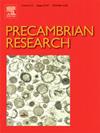西北阿拉伯板块埃迪卡拉纪碳酸盐-硅屑混合体系的沉积构型:区域性海侵还是同构造断控盆地?
IF 3.2
2区 地球科学
Q2 GEOSCIENCES, MULTIDISCIPLINARY
引用次数: 0
摘要
世界范围内埃迪卡拉系沉积序列的共同特征是同生沉积的混合硅屑-碳酸盐沉积。在阿拉伯板块的西北部分,沿着北西走向的纳杰断裂系统,在一系列孤立的盆地内观察到类似的沉积风格。提出了两种不同的沉积模式来解释该地区km厚埃迪卡拉纪沉积序列的形成,即从区域扩张的海相台地到断层控制的同构造沉积盆地。到目前为止,这个问题仍然没有答案,控制这些埃迪卡拉纪序列的形成模式、演化和沉积结构的控制因素仍然是个谜。本研究通过对沿沙特阿拉伯西部纳伊德断裂体系形成的埃迪卡拉系达伊卡盆地进行详细的沉积学和地层学分析,探讨了这种硅屑与碳酸盐混合沉积。确定了8种沉积相,从多晶砾岩到微生物碳酸盐,最有可能代表大陆(冲积到湖泊)到边缘海相环境的聚集。除了同沉积构造活动的沉积学证据外,我们还观察到4个3级的精深向上层序,这可能表明海卡盆地与局部构造活动有关的多期断裂控制沉积。层序排列和厚度的变化进一步表明了盆地局部可容纳空间发育的离散波动。这些发现强调了阿拉伯-努比亚地盾埃迪卡拉盆地的沉积风格可能主要受局部断层相关调节的控制,这可能与许多记录相对基准面和起伏基准面变化的埃迪卡拉序列不同,但与构造作用影响地区形成的盆地相似。这些信息为比较分布在阿拉伯-努比亚盾西北地区的多个孤立盆地中的埃迪卡拉系岩石提供了一个更好的框架,并为这些序列与世界范围内类似同构造盆地的混合硅屑-碳酸盐岩序列的对比提供了基础。本文章由计算机程序翻译,如有差异,请以英文原文为准。
Sedimentary architecture of the ediacaran mixed carbonate-siliciclastic system, NW arabian plate: Regionally extensive marine incursion or syntectonic fault-controlled basin?
Ediacaran sedimentary successions worldwide are commonly characterized by mixed siliciclastic-carbonate deposits exhibiting contemporaneous deposition. In NW parts of the Arabian plate, a similar style of sedimentation is observed within a series of isolated basins along the NW-trending Najd Fault System. Two contrasting depositional models have been proposed to explain the formation of Km-thick Ediacaran sedimentary sequences in the region, from regionally extensive marine platform to fault-controlled basins with syntectonic deposition. To date, this question remains unanswered and the controlling factors governing the mode of formation, the evolution and the sedimentary architecture for these Ediacaran sequences remain enigmatic. In this study, we explore this mixed siliciclastic and carbonate sedimentation by conducting detailed sedimentology and stratigraphic analysis of the Ediacaran Dhaiqa basin, a transtensional basin formed along the Najd Fault system of western Saudi Arabia. Eight sedimentary facies are identified, ranging from polymict conglomerate to microbial carbonate which most likely represent accumulation in continental (alluvial to lacustrine) to marginal marine settings. In addition to sedimentological evidences for syn-sedimentary tectonic activity, we observed four 3rd-order fining- and deepening-upwards sequences, which may suggest multi-stage, fault-controlled sedimentation related to local tectonic activity in the Dhaiqa basin. Variations in sequence arrangement and thickness further indicate discrete fluctuations in the development of local accommodation space in the basin. These findings highlight how the style of sedimentation in the Ediacaran basins of the Arabian-Nubian Shield may be primarily controlled by local fault-related accommodation, which might differ from many Ediacaran successions that record relative and eustatic base level changes, but is similar to the basins formed in the regions influenced by tectonism. Such information provides a better framework to compare Ediacaran rocks across multiple isolated basins spread across the northwestern regions of the Arabian-Nubian Shield, and may provide base for the future correlations of these sequences with mixed siliciclastic carbonate successions in similar syn-tectonic basins worldwide.
求助全文
通过发布文献求助,成功后即可免费获取论文全文。
去求助
来源期刊

Precambrian Research
地学-地球科学综合
CiteScore
7.20
自引率
28.90%
发文量
325
审稿时长
12 months
期刊介绍:
Precambrian Research publishes studies on all aspects of the early stages of the composition, structure and evolution of the Earth and its planetary neighbours. With a focus on process-oriented and comparative studies, it covers, but is not restricted to, subjects such as:
(1) Chemical, biological, biochemical and cosmochemical evolution; the origin of life; the evolution of the oceans and atmosphere; the early fossil record; palaeobiology;
(2) Geochronology and isotope and elemental geochemistry;
(3) Precambrian mineral deposits;
(4) Geophysical aspects of the early Earth and Precambrian terrains;
(5) Nature, formation and evolution of the Precambrian lithosphere and mantle including magmatic, depositional, metamorphic and tectonic processes.
In addition, the editors particularly welcome integrated process-oriented studies that involve a combination of the above fields and comparative studies that demonstrate the effect of Precambrian evolution on Phanerozoic earth system processes.
Regional and localised studies of Precambrian phenomena are considered appropriate only when the detail and quality allow illustration of a wider process, or when significant gaps in basic knowledge of a particular area can be filled.
 求助内容:
求助内容: 应助结果提醒方式:
应助结果提醒方式:


